Leadership and Management for Service Industries - Coursework Report
VerifiedAdded on 2020/10/05
|11
|3070
|214
Report
AI Summary
This report delves into the critical aspects of leadership and management within the service industry, using Hazev Restaurant as a case study. It begins by exploring classical management theories and different leadership styles, such as autocratic, democratic, and transformational leadership, within the context of service sector organizations. The report then examines the roles and responsibilities of leaders, including strategy execution, inspiring trust, and coaching potential. Furthermore, it reviews the specific management and leadership styles employed by Hazev, Haz, and Tas restaurant chains, highlighting the adoption of transformational leadership and democratic management. The analysis extends to internal and external factors influencing management styles, such as complex finance, organizational culture, and employee diversity. The report concludes with a comparison of change management styles and leadership approaches across different service industry organizations.
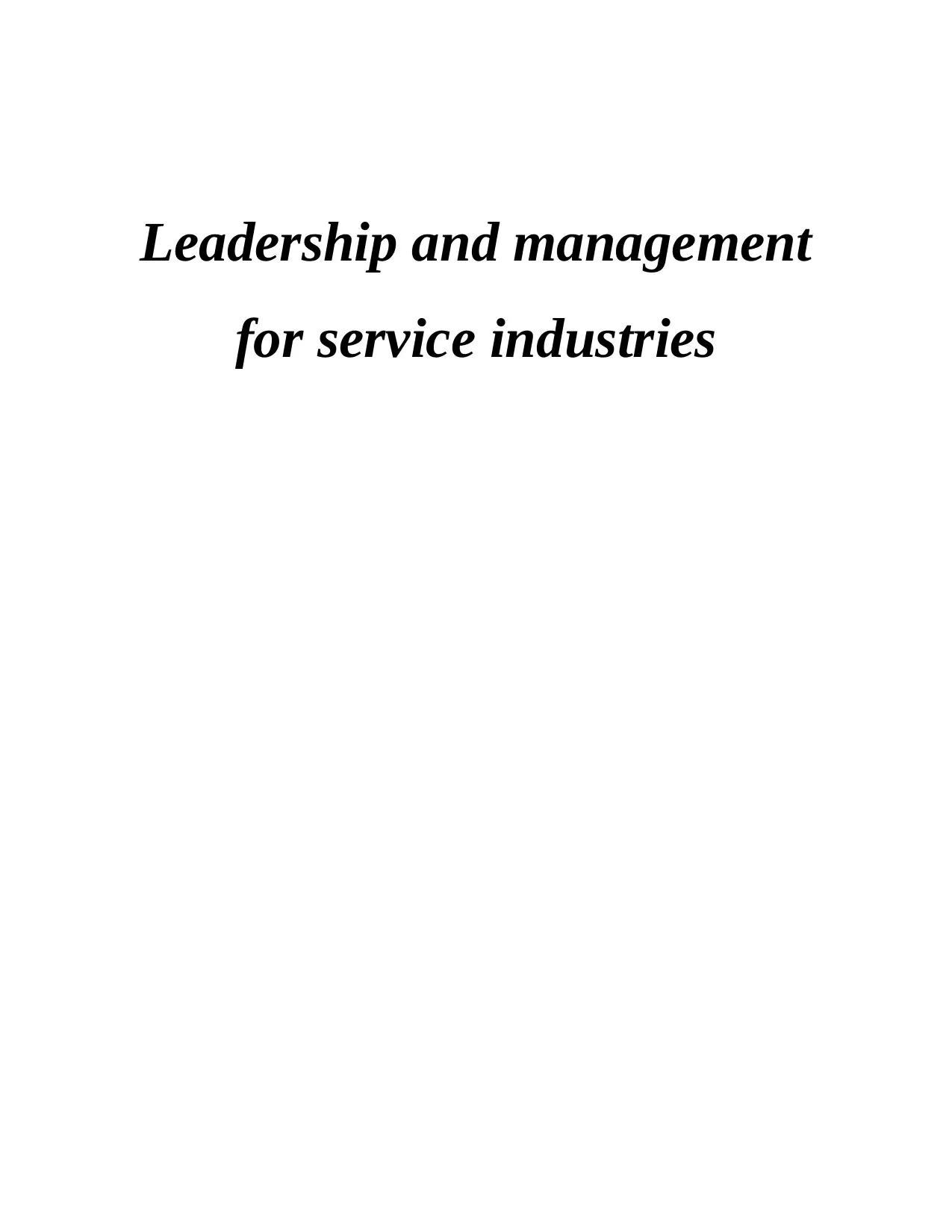
Leadership and management
for service industries
for service industries
Paraphrase This Document
Need a fresh take? Get an instant paraphrase of this document with our AI Paraphraser
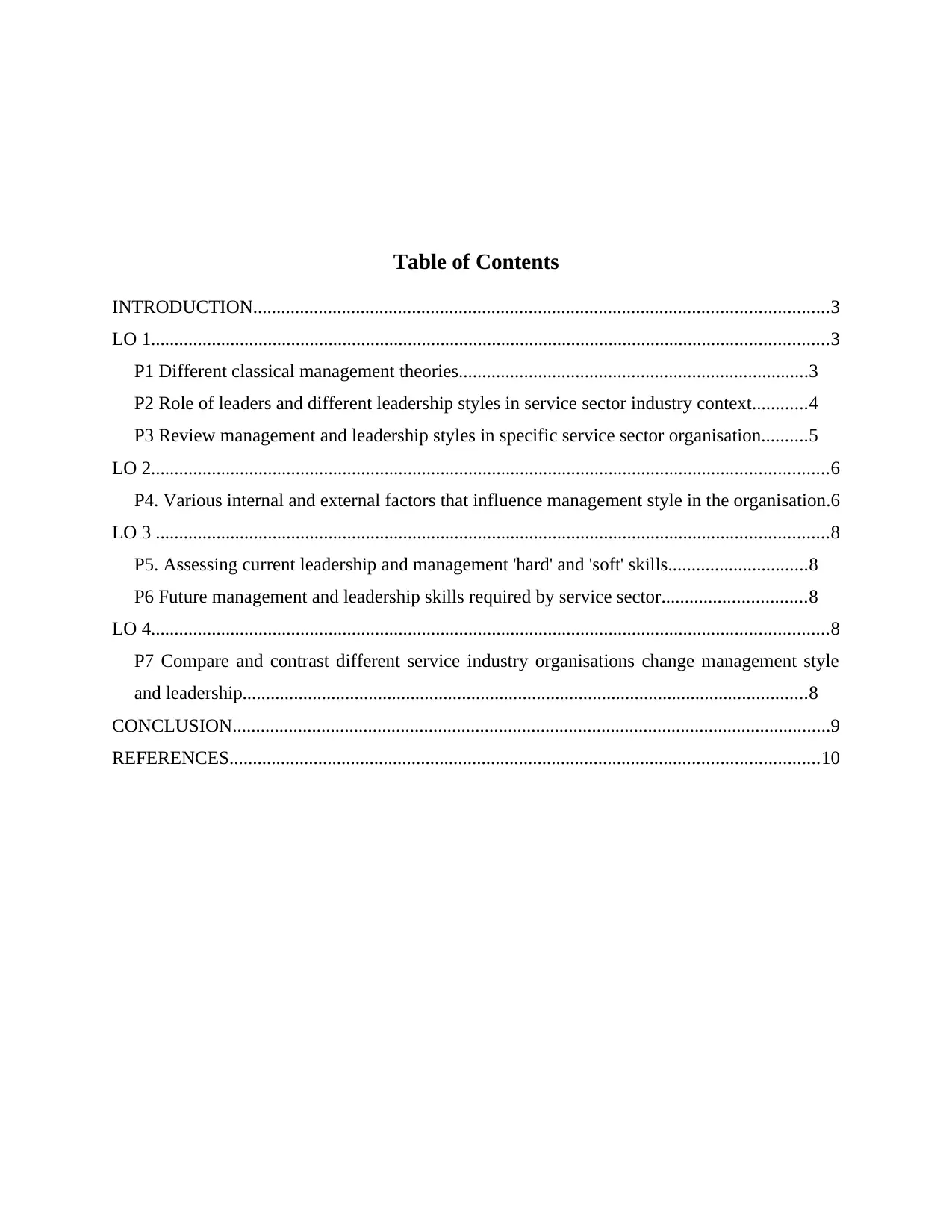
Table of Contents
INTRODUCTION...........................................................................................................................3
LO 1.................................................................................................................................................3
P1 Different classical management theories...........................................................................3
P2 Role of leaders and different leadership styles in service sector industry context............4
P3 Review management and leadership styles in specific service sector organisation..........5
LO 2.................................................................................................................................................6
P4. Various internal and external factors that influence management style in the organisation.6
LO 3 ................................................................................................................................................8
P5. Assessing current leadership and management 'hard' and 'soft' skills..............................8
P6 Future management and leadership skills required by service sector...............................8
LO 4.................................................................................................................................................8
P7 Compare and contrast different service industry organisations change management style
and leadership.........................................................................................................................8
CONCLUSION................................................................................................................................9
REFERENCES..............................................................................................................................10
INTRODUCTION...........................................................................................................................3
LO 1.................................................................................................................................................3
P1 Different classical management theories...........................................................................3
P2 Role of leaders and different leadership styles in service sector industry context............4
P3 Review management and leadership styles in specific service sector organisation..........5
LO 2.................................................................................................................................................6
P4. Various internal and external factors that influence management style in the organisation.6
LO 3 ................................................................................................................................................8
P5. Assessing current leadership and management 'hard' and 'soft' skills..............................8
P6 Future management and leadership skills required by service sector...............................8
LO 4.................................................................................................................................................8
P7 Compare and contrast different service industry organisations change management style
and leadership.........................................................................................................................8
CONCLUSION................................................................................................................................9
REFERENCES..............................................................................................................................10
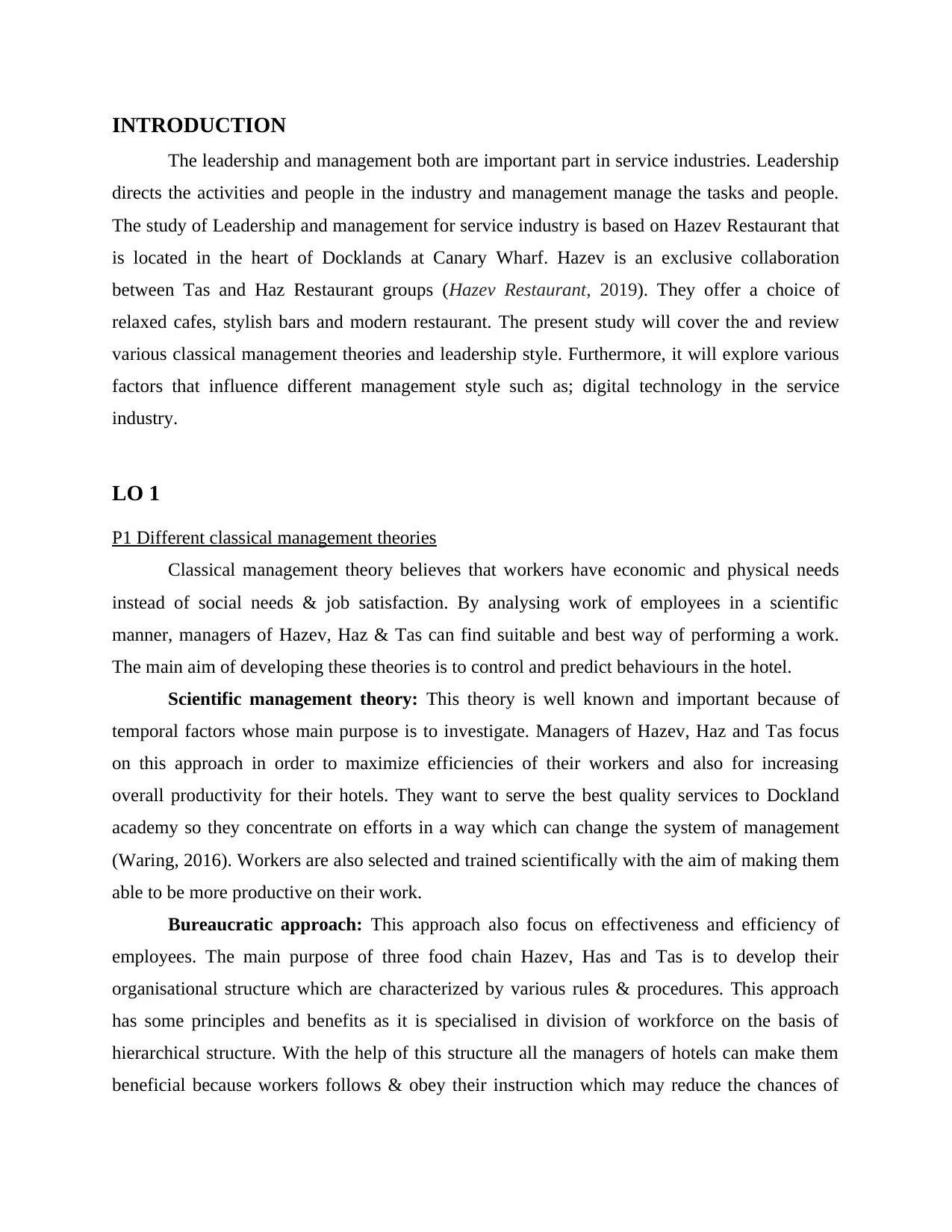
INTRODUCTION
The leadership and management both are important part in service industries. Leadership
directs the activities and people in the industry and management manage the tasks and people.
The study of Leadership and management for service industry is based on Hazev Restaurant that
is located in the heart of Docklands at Canary Wharf. Hazev is an exclusive collaboration
between Tas and Haz Restaurant groups (Hazev Restaurant, 2019). They offer a choice of
relaxed cafes, stylish bars and modern restaurant. The present study will cover the and review
various classical management theories and leadership style. Furthermore, it will explore various
factors that influence different management style such as; digital technology in the service
industry.
LO 1
P1 Different classical management theories
Classical management theory believes that workers have economic and physical needs
instead of social needs & job satisfaction. By analysing work of employees in a scientific
manner, managers of Hazev, Haz & Tas can find suitable and best way of performing a work.
The main aim of developing these theories is to control and predict behaviours in the hotel.
Scientific management theory: This theory is well known and important because of
temporal factors whose main purpose is to investigate. Managers of Hazev, Haz and Tas focus
on this approach in order to maximize efficiencies of their workers and also for increasing
overall productivity for their hotels. They want to serve the best quality services to Dockland
academy so they concentrate on efforts in a way which can change the system of management
(Waring, 2016). Workers are also selected and trained scientifically with the aim of making them
able to be more productive on their work.
Bureaucratic approach: This approach also focus on effectiveness and efficiency of
employees. The main purpose of three food chain Hazev, Has and Tas is to develop their
organisational structure which are characterized by various rules & procedures. This approach
has some principles and benefits as it is specialised in division of workforce on the basis of
hierarchical structure. With the help of this structure all the managers of hotels can make them
beneficial because workers follows & obey their instruction which may reduce the chances of
The leadership and management both are important part in service industries. Leadership
directs the activities and people in the industry and management manage the tasks and people.
The study of Leadership and management for service industry is based on Hazev Restaurant that
is located in the heart of Docklands at Canary Wharf. Hazev is an exclusive collaboration
between Tas and Haz Restaurant groups (Hazev Restaurant, 2019). They offer a choice of
relaxed cafes, stylish bars and modern restaurant. The present study will cover the and review
various classical management theories and leadership style. Furthermore, it will explore various
factors that influence different management style such as; digital technology in the service
industry.
LO 1
P1 Different classical management theories
Classical management theory believes that workers have economic and physical needs
instead of social needs & job satisfaction. By analysing work of employees in a scientific
manner, managers of Hazev, Haz & Tas can find suitable and best way of performing a work.
The main aim of developing these theories is to control and predict behaviours in the hotel.
Scientific management theory: This theory is well known and important because of
temporal factors whose main purpose is to investigate. Managers of Hazev, Haz and Tas focus
on this approach in order to maximize efficiencies of their workers and also for increasing
overall productivity for their hotels. They want to serve the best quality services to Dockland
academy so they concentrate on efforts in a way which can change the system of management
(Waring, 2016). Workers are also selected and trained scientifically with the aim of making them
able to be more productive on their work.
Bureaucratic approach: This approach also focus on effectiveness and efficiency of
employees. The main purpose of three food chain Hazev, Has and Tas is to develop their
organisational structure which are characterized by various rules & procedures. This approach
has some principles and benefits as it is specialised in division of workforce on the basis of
hierarchical structure. With the help of this structure all the managers of hotels can make them
beneficial because workers follows & obey their instruction which may reduce the chances of
⊘ This is a preview!⊘
Do you want full access?
Subscribe today to unlock all pages.

Trusted by 1+ million students worldwide
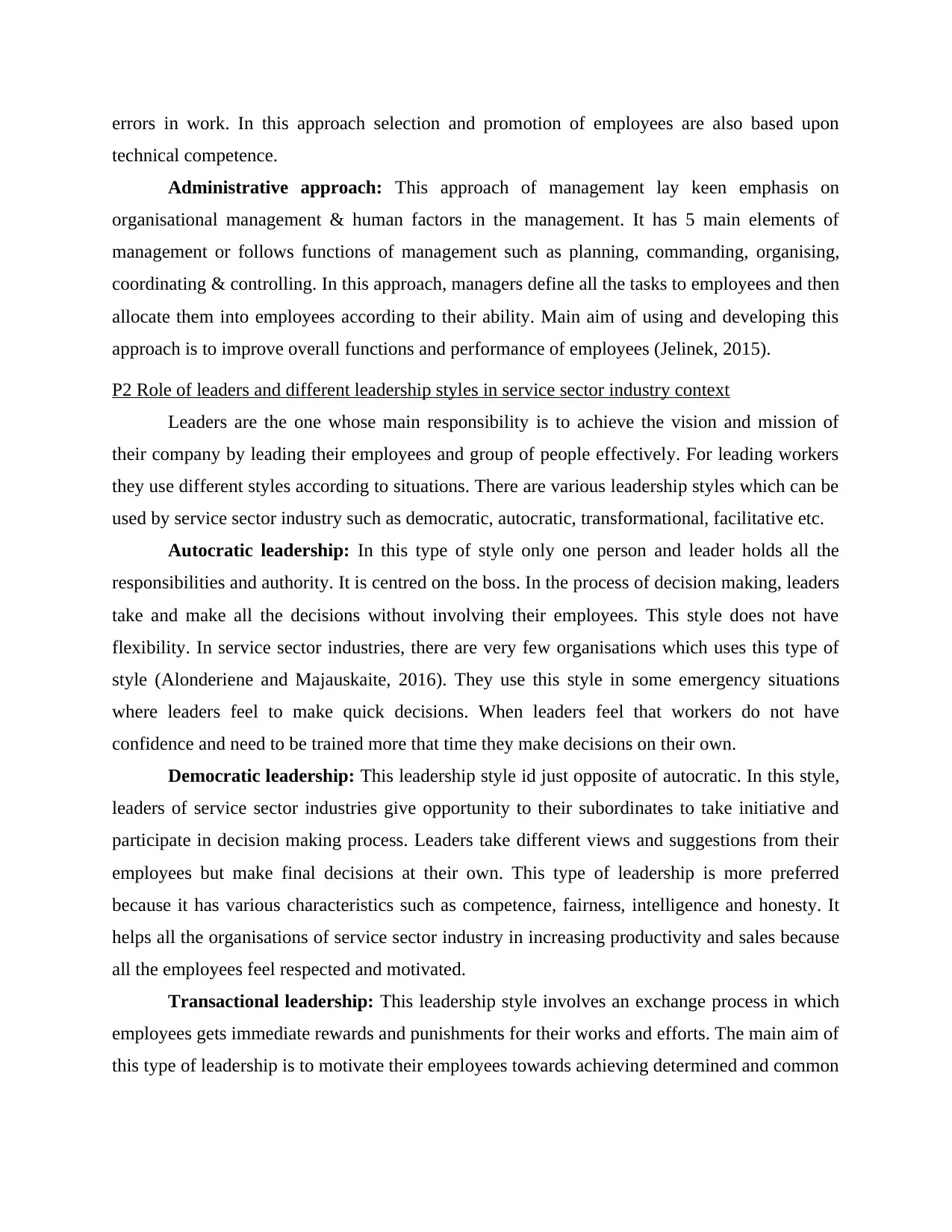
errors in work. In this approach selection and promotion of employees are also based upon
technical competence.
Administrative approach: This approach of management lay keen emphasis on
organisational management & human factors in the management. It has 5 main elements of
management or follows functions of management such as planning, commanding, organising,
coordinating & controlling. In this approach, managers define all the tasks to employees and then
allocate them into employees according to their ability. Main aim of using and developing this
approach is to improve overall functions and performance of employees (Jelinek, 2015).
P2 Role of leaders and different leadership styles in service sector industry context
Leaders are the one whose main responsibility is to achieve the vision and mission of
their company by leading their employees and group of people effectively. For leading workers
they use different styles according to situations. There are various leadership styles which can be
used by service sector industry such as democratic, autocratic, transformational, facilitative etc.
Autocratic leadership: In this type of style only one person and leader holds all the
responsibilities and authority. It is centred on the boss. In the process of decision making, leaders
take and make all the decisions without involving their employees. This style does not have
flexibility. In service sector industries, there are very few organisations which uses this type of
style (Alonderiene and Majauskaite, 2016). They use this style in some emergency situations
where leaders feel to make quick decisions. When leaders feel that workers do not have
confidence and need to be trained more that time they make decisions on their own.
Democratic leadership: This leadership style id just opposite of autocratic. In this style,
leaders of service sector industries give opportunity to their subordinates to take initiative and
participate in decision making process. Leaders take different views and suggestions from their
employees but make final decisions at their own. This type of leadership is more preferred
because it has various characteristics such as competence, fairness, intelligence and honesty. It
helps all the organisations of service sector industry in increasing productivity and sales because
all the employees feel respected and motivated.
Transactional leadership: This leadership style involves an exchange process in which
employees gets immediate rewards and punishments for their works and efforts. The main aim of
this type of leadership is to motivate their employees towards achieving determined and common
technical competence.
Administrative approach: This approach of management lay keen emphasis on
organisational management & human factors in the management. It has 5 main elements of
management or follows functions of management such as planning, commanding, organising,
coordinating & controlling. In this approach, managers define all the tasks to employees and then
allocate them into employees according to their ability. Main aim of using and developing this
approach is to improve overall functions and performance of employees (Jelinek, 2015).
P2 Role of leaders and different leadership styles in service sector industry context
Leaders are the one whose main responsibility is to achieve the vision and mission of
their company by leading their employees and group of people effectively. For leading workers
they use different styles according to situations. There are various leadership styles which can be
used by service sector industry such as democratic, autocratic, transformational, facilitative etc.
Autocratic leadership: In this type of style only one person and leader holds all the
responsibilities and authority. It is centred on the boss. In the process of decision making, leaders
take and make all the decisions without involving their employees. This style does not have
flexibility. In service sector industries, there are very few organisations which uses this type of
style (Alonderiene and Majauskaite, 2016). They use this style in some emergency situations
where leaders feel to make quick decisions. When leaders feel that workers do not have
confidence and need to be trained more that time they make decisions on their own.
Democratic leadership: This leadership style id just opposite of autocratic. In this style,
leaders of service sector industries give opportunity to their subordinates to take initiative and
participate in decision making process. Leaders take different views and suggestions from their
employees but make final decisions at their own. This type of leadership is more preferred
because it has various characteristics such as competence, fairness, intelligence and honesty. It
helps all the organisations of service sector industry in increasing productivity and sales because
all the employees feel respected and motivated.
Transactional leadership: This leadership style involves an exchange process in which
employees gets immediate rewards and punishments for their works and efforts. The main aim of
this type of leadership is to motivate their employees towards achieving determined and common
Paraphrase This Document
Need a fresh take? Get an instant paraphrase of this document with our AI Paraphraser
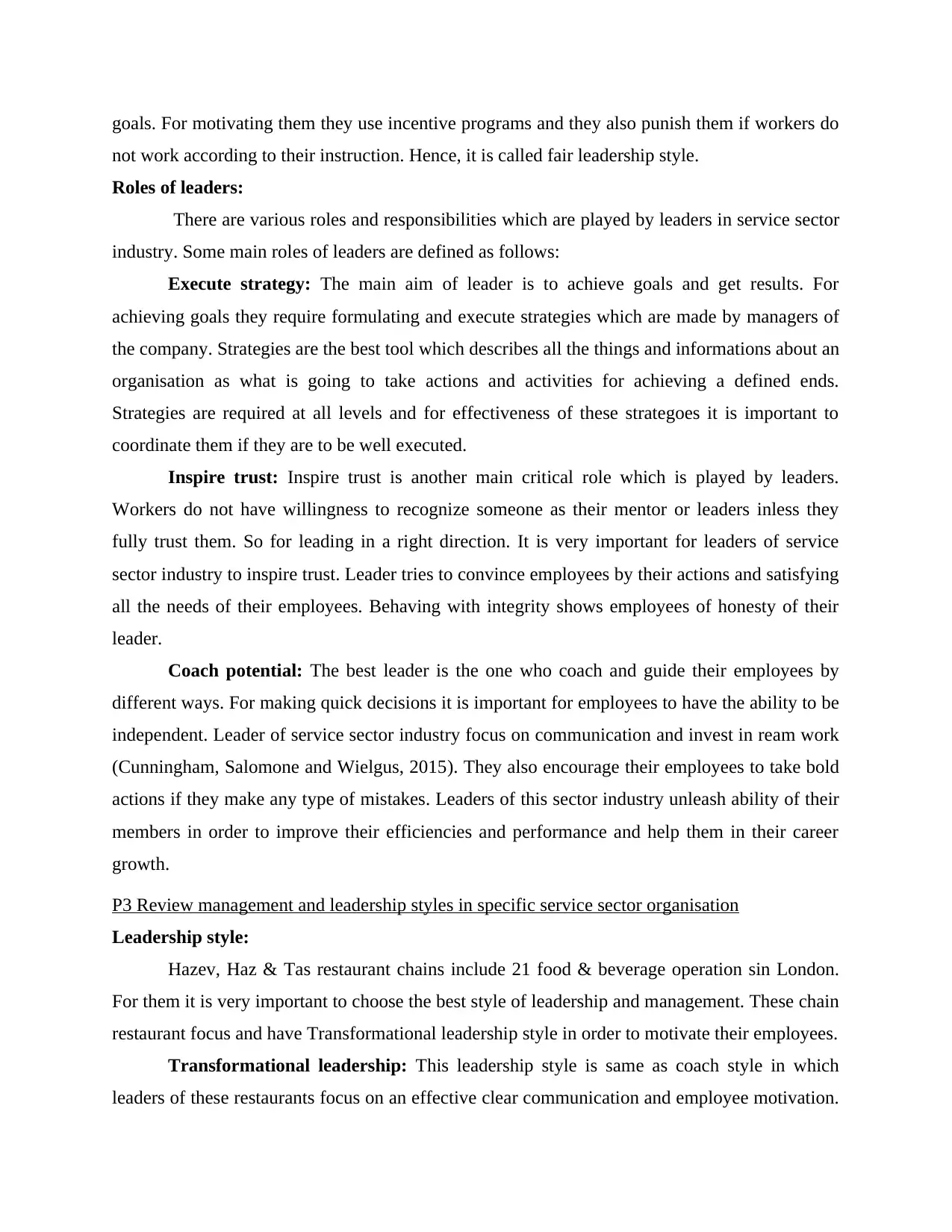
goals. For motivating them they use incentive programs and they also punish them if workers do
not work according to their instruction. Hence, it is called fair leadership style.
Roles of leaders:
There are various roles and responsibilities which are played by leaders in service sector
industry. Some main roles of leaders are defined as follows:
Execute strategy: The main aim of leader is to achieve goals and get results. For
achieving goals they require formulating and execute strategies which are made by managers of
the company. Strategies are the best tool which describes all the things and informations about an
organisation as what is going to take actions and activities for achieving a defined ends.
Strategies are required at all levels and for effectiveness of these strategoes it is important to
coordinate them if they are to be well executed.
Inspire trust: Inspire trust is another main critical role which is played by leaders.
Workers do not have willingness to recognize someone as their mentor or leaders inless they
fully trust them. So for leading in a right direction. It is very important for leaders of service
sector industry to inspire trust. Leader tries to convince employees by their actions and satisfying
all the needs of their employees. Behaving with integrity shows employees of honesty of their
leader.
Coach potential: The best leader is the one who coach and guide their employees by
different ways. For making quick decisions it is important for employees to have the ability to be
independent. Leader of service sector industry focus on communication and invest in ream work
(Cunningham, Salomone and Wielgus, 2015). They also encourage their employees to take bold
actions if they make any type of mistakes. Leaders of this sector industry unleash ability of their
members in order to improve their efficiencies and performance and help them in their career
growth.
P3 Review management and leadership styles in specific service sector organisation
Leadership style:
Hazev, Haz & Tas restaurant chains include 21 food & beverage operation sin London.
For them it is very important to choose the best style of leadership and management. These chain
restaurant focus and have Transformational leadership style in order to motivate their employees.
Transformational leadership: This leadership style is same as coach style in which
leaders of these restaurants focus on an effective clear communication and employee motivation.
not work according to their instruction. Hence, it is called fair leadership style.
Roles of leaders:
There are various roles and responsibilities which are played by leaders in service sector
industry. Some main roles of leaders are defined as follows:
Execute strategy: The main aim of leader is to achieve goals and get results. For
achieving goals they require formulating and execute strategies which are made by managers of
the company. Strategies are the best tool which describes all the things and informations about an
organisation as what is going to take actions and activities for achieving a defined ends.
Strategies are required at all levels and for effectiveness of these strategoes it is important to
coordinate them if they are to be well executed.
Inspire trust: Inspire trust is another main critical role which is played by leaders.
Workers do not have willingness to recognize someone as their mentor or leaders inless they
fully trust them. So for leading in a right direction. It is very important for leaders of service
sector industry to inspire trust. Leader tries to convince employees by their actions and satisfying
all the needs of their employees. Behaving with integrity shows employees of honesty of their
leader.
Coach potential: The best leader is the one who coach and guide their employees by
different ways. For making quick decisions it is important for employees to have the ability to be
independent. Leader of service sector industry focus on communication and invest in ream work
(Cunningham, Salomone and Wielgus, 2015). They also encourage their employees to take bold
actions if they make any type of mistakes. Leaders of this sector industry unleash ability of their
members in order to improve their efficiencies and performance and help them in their career
growth.
P3 Review management and leadership styles in specific service sector organisation
Leadership style:
Hazev, Haz & Tas restaurant chains include 21 food & beverage operation sin London.
For them it is very important to choose the best style of leadership and management. These chain
restaurant focus and have Transformational leadership style in order to motivate their employees.
Transformational leadership: This leadership style is same as coach style in which
leaders of these restaurants focus on an effective clear communication and employee motivation.
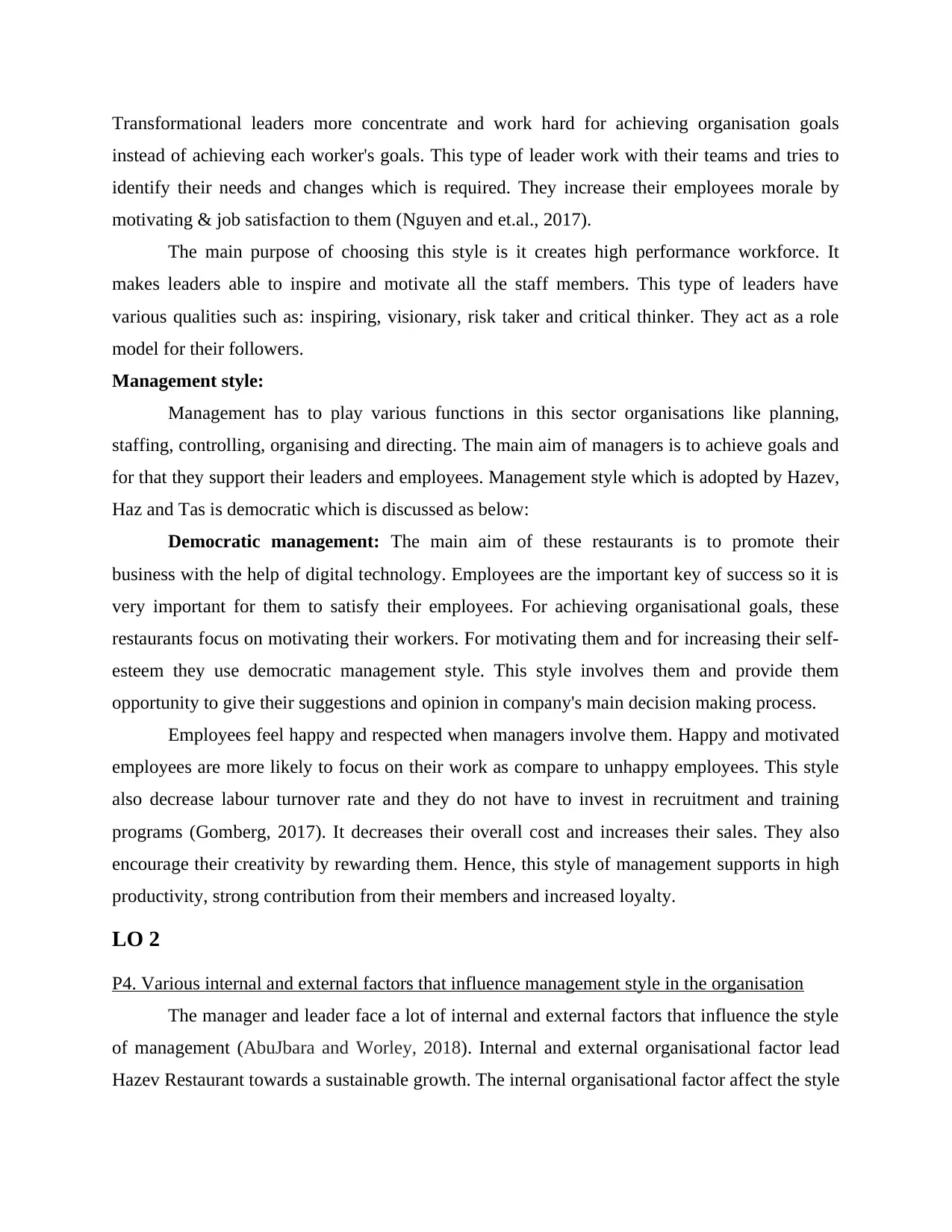
Transformational leaders more concentrate and work hard for achieving organisation goals
instead of achieving each worker's goals. This type of leader work with their teams and tries to
identify their needs and changes which is required. They increase their employees morale by
motivating & job satisfaction to them (Nguyen and et.al., 2017).
The main purpose of choosing this style is it creates high performance workforce. It
makes leaders able to inspire and motivate all the staff members. This type of leaders have
various qualities such as: inspiring, visionary, risk taker and critical thinker. They act as a role
model for their followers.
Management style:
Management has to play various functions in this sector organisations like planning,
staffing, controlling, organising and directing. The main aim of managers is to achieve goals and
for that they support their leaders and employees. Management style which is adopted by Hazev,
Haz and Tas is democratic which is discussed as below:
Democratic management: The main aim of these restaurants is to promote their
business with the help of digital technology. Employees are the important key of success so it is
very important for them to satisfy their employees. For achieving organisational goals, these
restaurants focus on motivating their workers. For motivating them and for increasing their self-
esteem they use democratic management style. This style involves them and provide them
opportunity to give their suggestions and opinion in company's main decision making process.
Employees feel happy and respected when managers involve them. Happy and motivated
employees are more likely to focus on their work as compare to unhappy employees. This style
also decrease labour turnover rate and they do not have to invest in recruitment and training
programs (Gomberg, 2017). It decreases their overall cost and increases their sales. They also
encourage their creativity by rewarding them. Hence, this style of management supports in high
productivity, strong contribution from their members and increased loyalty.
LO 2
P4. Various internal and external factors that influence management style in the organisation
The manager and leader face a lot of internal and external factors that influence the style
of management (AbuJbara and Worley, 2018). Internal and external organisational factor lead
Hazev Restaurant towards a sustainable growth. The internal organisational factor affect the style
instead of achieving each worker's goals. This type of leader work with their teams and tries to
identify their needs and changes which is required. They increase their employees morale by
motivating & job satisfaction to them (Nguyen and et.al., 2017).
The main purpose of choosing this style is it creates high performance workforce. It
makes leaders able to inspire and motivate all the staff members. This type of leaders have
various qualities such as: inspiring, visionary, risk taker and critical thinker. They act as a role
model for their followers.
Management style:
Management has to play various functions in this sector organisations like planning,
staffing, controlling, organising and directing. The main aim of managers is to achieve goals and
for that they support their leaders and employees. Management style which is adopted by Hazev,
Haz and Tas is democratic which is discussed as below:
Democratic management: The main aim of these restaurants is to promote their
business with the help of digital technology. Employees are the important key of success so it is
very important for them to satisfy their employees. For achieving organisational goals, these
restaurants focus on motivating their workers. For motivating them and for increasing their self-
esteem they use democratic management style. This style involves them and provide them
opportunity to give their suggestions and opinion in company's main decision making process.
Employees feel happy and respected when managers involve them. Happy and motivated
employees are more likely to focus on their work as compare to unhappy employees. This style
also decrease labour turnover rate and they do not have to invest in recruitment and training
programs (Gomberg, 2017). It decreases their overall cost and increases their sales. They also
encourage their creativity by rewarding them. Hence, this style of management supports in high
productivity, strong contribution from their members and increased loyalty.
LO 2
P4. Various internal and external factors that influence management style in the organisation
The manager and leader face a lot of internal and external factors that influence the style
of management (AbuJbara and Worley, 2018). Internal and external organisational factor lead
Hazev Restaurant towards a sustainable growth. The internal organisational factor affect the style
⊘ This is a preview!⊘
Do you want full access?
Subscribe today to unlock all pages.

Trusted by 1+ million students worldwide
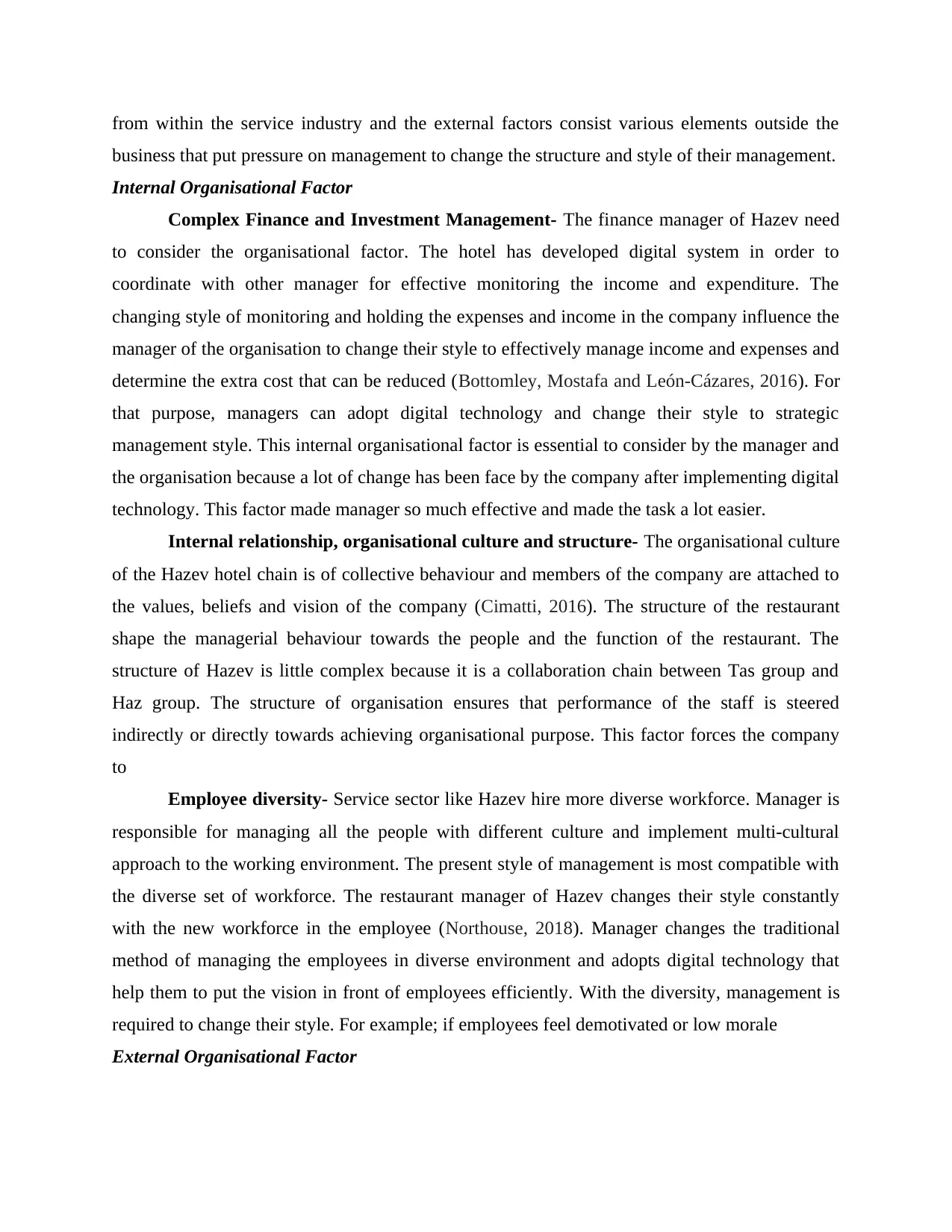
from within the service industry and the external factors consist various elements outside the
business that put pressure on management to change the structure and style of their management.
Internal Organisational Factor
Complex Finance and Investment Management- The finance manager of Hazev need
to consider the organisational factor. The hotel has developed digital system in order to
coordinate with other manager for effective monitoring the income and expenditure. The
changing style of monitoring and holding the expenses and income in the company influence the
manager of the organisation to change their style to effectively manage income and expenses and
determine the extra cost that can be reduced (Bottomley, Mostafa and León‐Cázares, 2016). For
that purpose, managers can adopt digital technology and change their style to strategic
management style. This internal organisational factor is essential to consider by the manager and
the organisation because a lot of change has been face by the company after implementing digital
technology. This factor made manager so much effective and made the task a lot easier.
Internal relationship, organisational culture and structure- The organisational culture
of the Hazev hotel chain is of collective behaviour and members of the company are attached to
the values, beliefs and vision of the company (Cimatti, 2016). The structure of the restaurant
shape the managerial behaviour towards the people and the function of the restaurant. The
structure of Hazev is little complex because it is a collaboration chain between Tas group and
Haz group. The structure of organisation ensures that performance of the staff is steered
indirectly or directly towards achieving organisational purpose. This factor forces the company
to
Employee diversity- Service sector like Hazev hire more diverse workforce. Manager is
responsible for managing all the people with different culture and implement multi-cultural
approach to the working environment. The present style of management is most compatible with
the diverse set of workforce. The restaurant manager of Hazev changes their style constantly
with the new workforce in the employee (Northouse, 2018). Manager changes the traditional
method of managing the employees in diverse environment and adopts digital technology that
help them to put the vision in front of employees efficiently. With the diversity, management is
required to change their style. For example; if employees feel demotivated or low morale
External Organisational Factor
business that put pressure on management to change the structure and style of their management.
Internal Organisational Factor
Complex Finance and Investment Management- The finance manager of Hazev need
to consider the organisational factor. The hotel has developed digital system in order to
coordinate with other manager for effective monitoring the income and expenditure. The
changing style of monitoring and holding the expenses and income in the company influence the
manager of the organisation to change their style to effectively manage income and expenses and
determine the extra cost that can be reduced (Bottomley, Mostafa and León‐Cázares, 2016). For
that purpose, managers can adopt digital technology and change their style to strategic
management style. This internal organisational factor is essential to consider by the manager and
the organisation because a lot of change has been face by the company after implementing digital
technology. This factor made manager so much effective and made the task a lot easier.
Internal relationship, organisational culture and structure- The organisational culture
of the Hazev hotel chain is of collective behaviour and members of the company are attached to
the values, beliefs and vision of the company (Cimatti, 2016). The structure of the restaurant
shape the managerial behaviour towards the people and the function of the restaurant. The
structure of Hazev is little complex because it is a collaboration chain between Tas group and
Haz group. The structure of organisation ensures that performance of the staff is steered
indirectly or directly towards achieving organisational purpose. This factor forces the company
to
Employee diversity- Service sector like Hazev hire more diverse workforce. Manager is
responsible for managing all the people with different culture and implement multi-cultural
approach to the working environment. The present style of management is most compatible with
the diverse set of workforce. The restaurant manager of Hazev changes their style constantly
with the new workforce in the employee (Northouse, 2018). Manager changes the traditional
method of managing the employees in diverse environment and adopts digital technology that
help them to put the vision in front of employees efficiently. With the diversity, management is
required to change their style. For example; if employees feel demotivated or low morale
External Organisational Factor
Paraphrase This Document
Need a fresh take? Get an instant paraphrase of this document with our AI Paraphraser
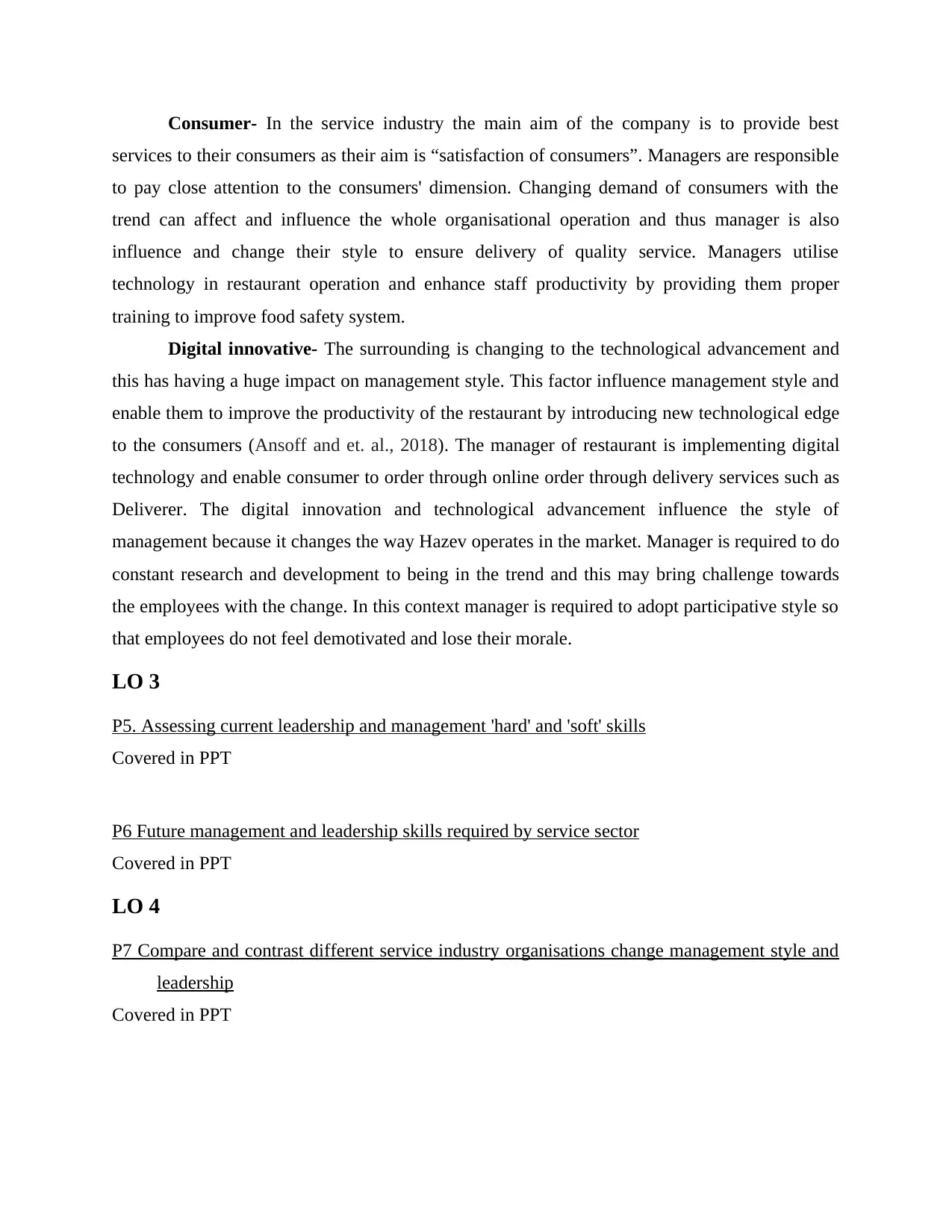
Consumer- In the service industry the main aim of the company is to provide best
services to their consumers as their aim is “satisfaction of consumers”. Managers are responsible
to pay close attention to the consumers' dimension. Changing demand of consumers with the
trend can affect and influence the whole organisational operation and thus manager is also
influence and change their style to ensure delivery of quality service. Managers utilise
technology in restaurant operation and enhance staff productivity by providing them proper
training to improve food safety system.
Digital innovative- The surrounding is changing to the technological advancement and
this has having a huge impact on management style. This factor influence management style and
enable them to improve the productivity of the restaurant by introducing new technological edge
to the consumers (Ansoff and et. al., 2018). The manager of restaurant is implementing digital
technology and enable consumer to order through online order through delivery services such as
Deliverer. The digital innovation and technological advancement influence the style of
management because it changes the way Hazev operates in the market. Manager is required to do
constant research and development to being in the trend and this may bring challenge towards
the employees with the change. In this context manager is required to adopt participative style so
that employees do not feel demotivated and lose their morale.
LO 3
P5. Assessing current leadership and management 'hard' and 'soft' skills
Covered in PPT
P6 Future management and leadership skills required by service sector
Covered in PPT
LO 4
P7 Compare and contrast different service industry organisations change management style and
leadership
Covered in PPT
services to their consumers as their aim is “satisfaction of consumers”. Managers are responsible
to pay close attention to the consumers' dimension. Changing demand of consumers with the
trend can affect and influence the whole organisational operation and thus manager is also
influence and change their style to ensure delivery of quality service. Managers utilise
technology in restaurant operation and enhance staff productivity by providing them proper
training to improve food safety system.
Digital innovative- The surrounding is changing to the technological advancement and
this has having a huge impact on management style. This factor influence management style and
enable them to improve the productivity of the restaurant by introducing new technological edge
to the consumers (Ansoff and et. al., 2018). The manager of restaurant is implementing digital
technology and enable consumer to order through online order through delivery services such as
Deliverer. The digital innovation and technological advancement influence the style of
management because it changes the way Hazev operates in the market. Manager is required to do
constant research and development to being in the trend and this may bring challenge towards
the employees with the change. In this context manager is required to adopt participative style so
that employees do not feel demotivated and lose their morale.
LO 3
P5. Assessing current leadership and management 'hard' and 'soft' skills
Covered in PPT
P6 Future management and leadership skills required by service sector
Covered in PPT
LO 4
P7 Compare and contrast different service industry organisations change management style and
leadership
Covered in PPT
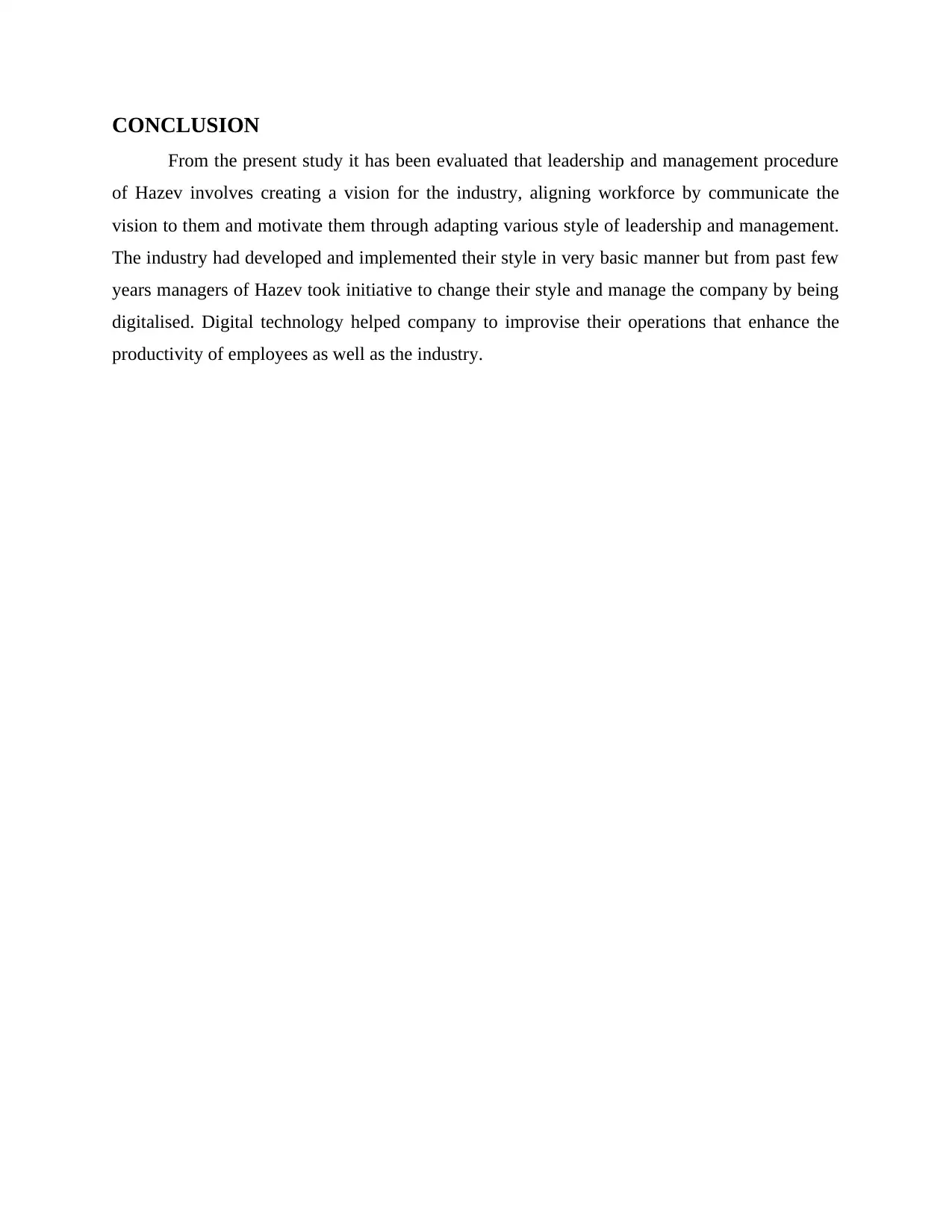
CONCLUSION
From the present study it has been evaluated that leadership and management procedure
of Hazev involves creating a vision for the industry, aligning workforce by communicate the
vision to them and motivate them through adapting various style of leadership and management.
The industry had developed and implemented their style in very basic manner but from past few
years managers of Hazev took initiative to change their style and manage the company by being
digitalised. Digital technology helped company to improvise their operations that enhance the
productivity of employees as well as the industry.
From the present study it has been evaluated that leadership and management procedure
of Hazev involves creating a vision for the industry, aligning workforce by communicate the
vision to them and motivate them through adapting various style of leadership and management.
The industry had developed and implemented their style in very basic manner but from past few
years managers of Hazev took initiative to change their style and manage the company by being
digitalised. Digital technology helped company to improvise their operations that enhance the
productivity of employees as well as the industry.
⊘ This is a preview!⊘
Do you want full access?
Subscribe today to unlock all pages.

Trusted by 1+ million students worldwide
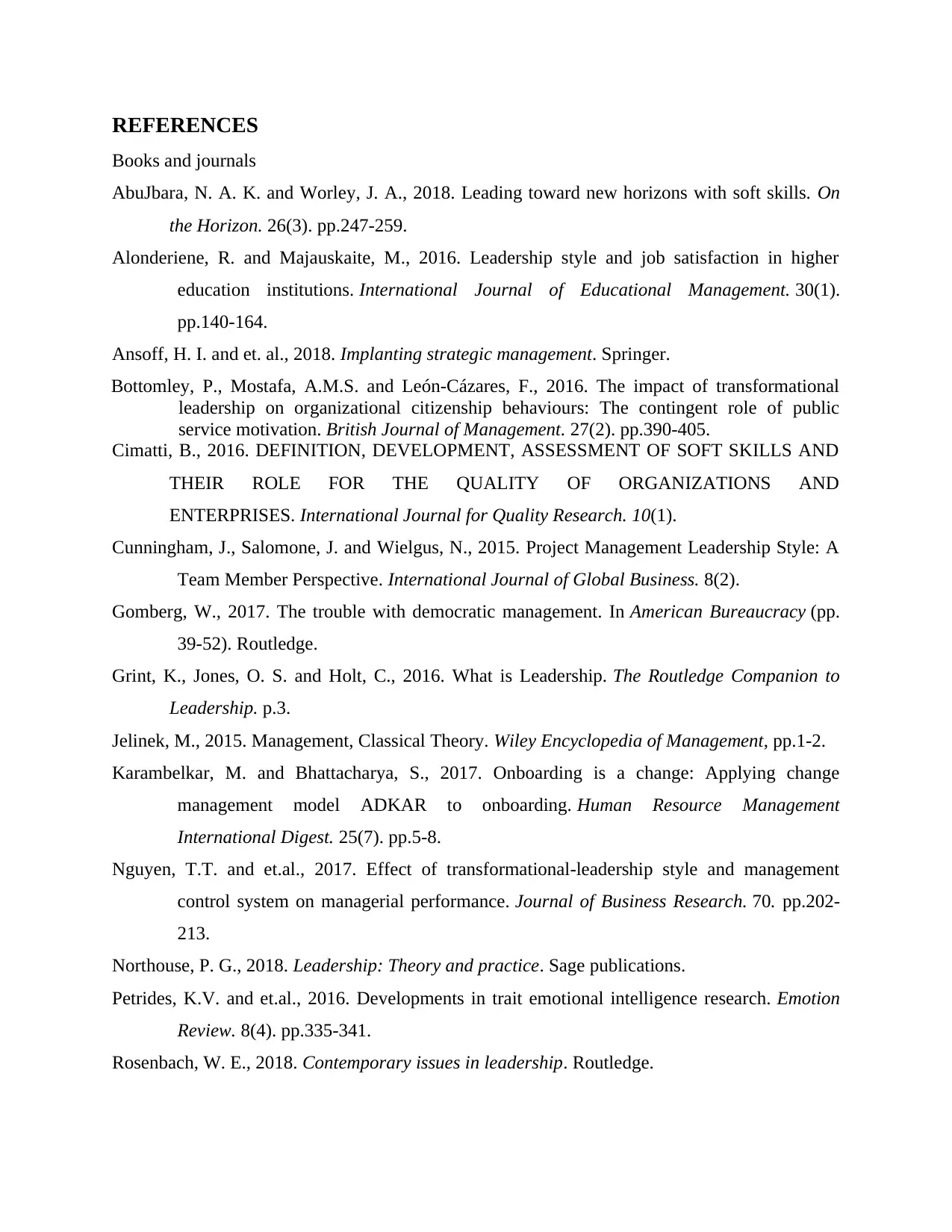
REFERENCES
Books and journals
AbuJbara, N. A. K. and Worley, J. A., 2018. Leading toward new horizons with soft skills. On
the Horizon. 26(3). pp.247-259.
Alonderiene, R. and Majauskaite, M., 2016. Leadership style and job satisfaction in higher
education institutions. International Journal of Educational Management. 30(1).
pp.140-164.
Ansoff, H. I. and et. al., 2018. Implanting strategic management. Springer.
Bottomley, P., Mostafa, A.M.S. and León‐Cázares, F., 2016. The impact of transformational
leadership on organizational citizenship behaviours: The contingent role of public
service motivation. British Journal of Management. 27(2). pp.390-405.
Cimatti, B., 2016. DEFINITION, DEVELOPMENT, ASSESSMENT OF SOFT SKILLS AND
THEIR ROLE FOR THE QUALITY OF ORGANIZATIONS AND
ENTERPRISES. International Journal for Quality Research. 10(1).
Cunningham, J., Salomone, J. and Wielgus, N., 2015. Project Management Leadership Style: A
Team Member Perspective. International Journal of Global Business. 8(2).
Gomberg, W., 2017. The trouble with democratic management. In American Bureaucracy (pp.
39-52). Routledge.
Grint, K., Jones, O. S. and Holt, C., 2016. What is Leadership. The Routledge Companion to
Leadership. p.3.
Jelinek, M., 2015. Management, Classical Theory. Wiley Encyclopedia of Management, pp.1-2.
Karambelkar, M. and Bhattacharya, S., 2017. Onboarding is a change: Applying change
management model ADKAR to onboarding. Human Resource Management
International Digest. 25(7). pp.5-8.
Nguyen, T.T. and et.al., 2017. Effect of transformational-leadership style and management
control system on managerial performance. Journal of Business Research. 70. pp.202-
213.
Northouse, P. G., 2018. Leadership: Theory and practice. Sage publications.
Petrides, K.V. and et.al., 2016. Developments in trait emotional intelligence research. Emotion
Review. 8(4). pp.335-341.
Rosenbach, W. E., 2018. Contemporary issues in leadership. Routledge.
Books and journals
AbuJbara, N. A. K. and Worley, J. A., 2018. Leading toward new horizons with soft skills. On
the Horizon. 26(3). pp.247-259.
Alonderiene, R. and Majauskaite, M., 2016. Leadership style and job satisfaction in higher
education institutions. International Journal of Educational Management. 30(1).
pp.140-164.
Ansoff, H. I. and et. al., 2018. Implanting strategic management. Springer.
Bottomley, P., Mostafa, A.M.S. and León‐Cázares, F., 2016. The impact of transformational
leadership on organizational citizenship behaviours: The contingent role of public
service motivation. British Journal of Management. 27(2). pp.390-405.
Cimatti, B., 2016. DEFINITION, DEVELOPMENT, ASSESSMENT OF SOFT SKILLS AND
THEIR ROLE FOR THE QUALITY OF ORGANIZATIONS AND
ENTERPRISES. International Journal for Quality Research. 10(1).
Cunningham, J., Salomone, J. and Wielgus, N., 2015. Project Management Leadership Style: A
Team Member Perspective. International Journal of Global Business. 8(2).
Gomberg, W., 2017. The trouble with democratic management. In American Bureaucracy (pp.
39-52). Routledge.
Grint, K., Jones, O. S. and Holt, C., 2016. What is Leadership. The Routledge Companion to
Leadership. p.3.
Jelinek, M., 2015. Management, Classical Theory. Wiley Encyclopedia of Management, pp.1-2.
Karambelkar, M. and Bhattacharya, S., 2017. Onboarding is a change: Applying change
management model ADKAR to onboarding. Human Resource Management
International Digest. 25(7). pp.5-8.
Nguyen, T.T. and et.al., 2017. Effect of transformational-leadership style and management
control system on managerial performance. Journal of Business Research. 70. pp.202-
213.
Northouse, P. G., 2018. Leadership: Theory and practice. Sage publications.
Petrides, K.V. and et.al., 2016. Developments in trait emotional intelligence research. Emotion
Review. 8(4). pp.335-341.
Rosenbach, W. E., 2018. Contemporary issues in leadership. Routledge.
Paraphrase This Document
Need a fresh take? Get an instant paraphrase of this document with our AI Paraphraser
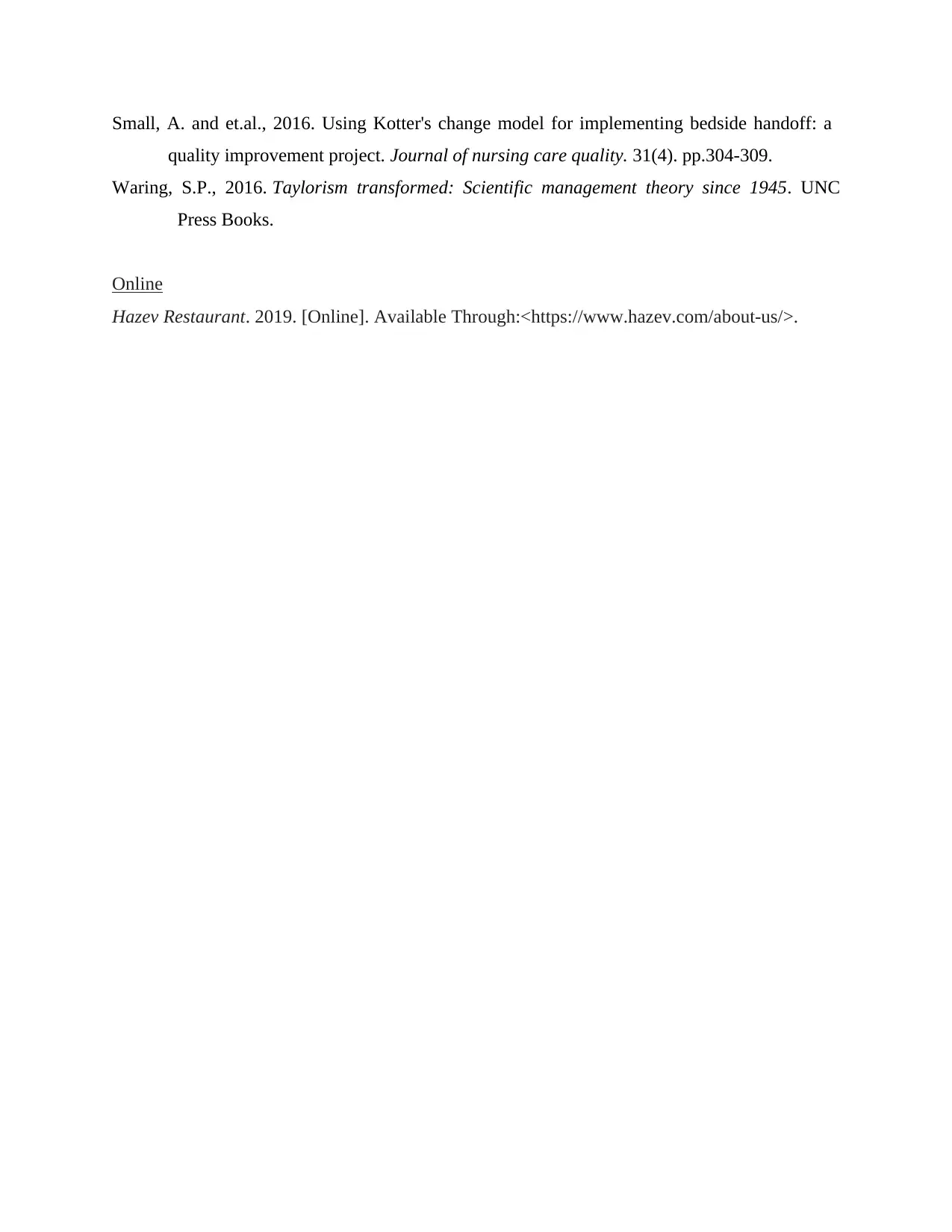
Small, A. and et.al., 2016. Using Kotter's change model for implementing bedside handoff: a
quality improvement project. Journal of nursing care quality. 31(4). pp.304-309.
Waring, S.P., 2016. Taylorism transformed: Scientific management theory since 1945. UNC
Press Books.
Online
Hazev Restaurant. 2019. [Online]. Available Through:<https://www.hazev.com/about-us/>.
quality improvement project. Journal of nursing care quality. 31(4). pp.304-309.
Waring, S.P., 2016. Taylorism transformed: Scientific management theory since 1945. UNC
Press Books.
Online
Hazev Restaurant. 2019. [Online]. Available Through:<https://www.hazev.com/about-us/>.
1 out of 11
Related Documents
Your All-in-One AI-Powered Toolkit for Academic Success.
+13062052269
info@desklib.com
Available 24*7 on WhatsApp / Email
![[object Object]](/_next/static/media/star-bottom.7253800d.svg)
Unlock your academic potential
Copyright © 2020–2025 A2Z Services. All Rights Reserved. Developed and managed by ZUCOL.





